




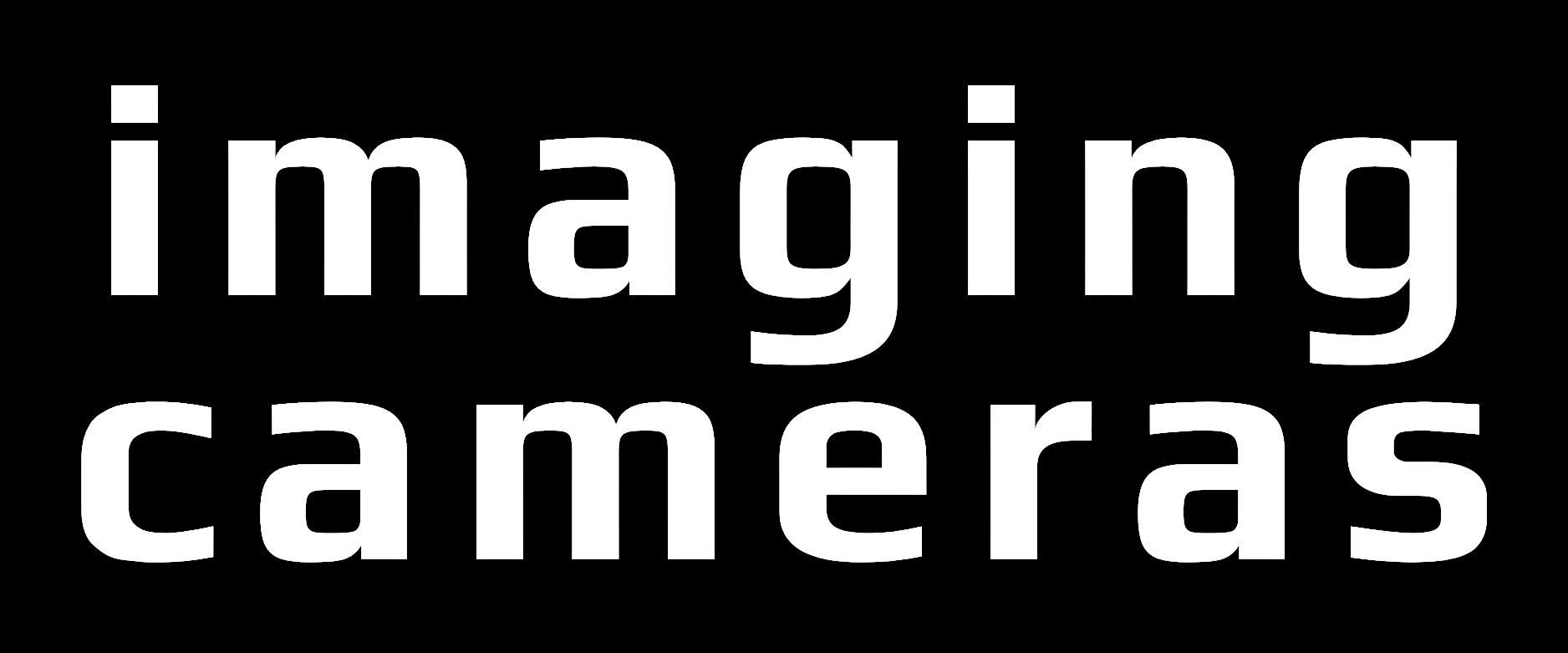

Raptor Launches
RCMOS – Cameras Ruggedised for Any Environment

BREAKTHROUGH IN BLACK PLASTIC SORTING
Detecting Foreign Objects On Food With Hyperspectral
The study of circadian rhythms and suprachiasmatic nucleus (SCN) neurons
High-speed framing and streak imaging cameras
Thermography on the Trail of the Fault
Edition No. 2
WITH CONTENT CONTRIBUTIONS FROM OUR PARTNERS:

Raptor Photonics
Raptor Photonics aims to provide world class low light level camera solutions to industrial, research and governmental organisations around the globe
Raptor Photonics Limited is a high-tech company based in Northern Ireland, which was established in September 2006. Its main focus is to design, manufacture and sell the next generation of high performance, cutting edge, low light level digital cameras.

Cordin Scientific
For Over Sixty Years, Cordin has been at the Pinnacle of High Speed Imaging. Cordin offers the fastest and highest quality scientific camera systems in the world: multichannel/multi-CCD framing cameras, image converter and rotating-mirror streak cameras, and compact single-chip framing cameras

Specim
Specim is a globally leading supplier in hyperspectral imaging As a true pioneer and forerunner in this field, we celebrated our 25th anniversary in 2020 Our international team of 70+ professionals, with expertise in optics, electronics, software, and machine vision, serves the market with the broadest range of hyperspectral cameras, imaging spectrographs, systems, and accessories We are known as a trusted partner with products and support of superb quality and cost-efficiency.

InfraTec
The Dresden-based company InfraTec GmbH is a specialist for products and services in the field of infrared technology. InfraTec offers solutions for every kind of thermographic measurement task. Discover the new generation of stationary and handheld infrared cameras with megapixel formats and automated thermography solutions
Contact us here at Quantum Design UK and Ireland to discuss your requirements
WWW.QD-UKI.CO.UK/IMAGING-CAMERAS

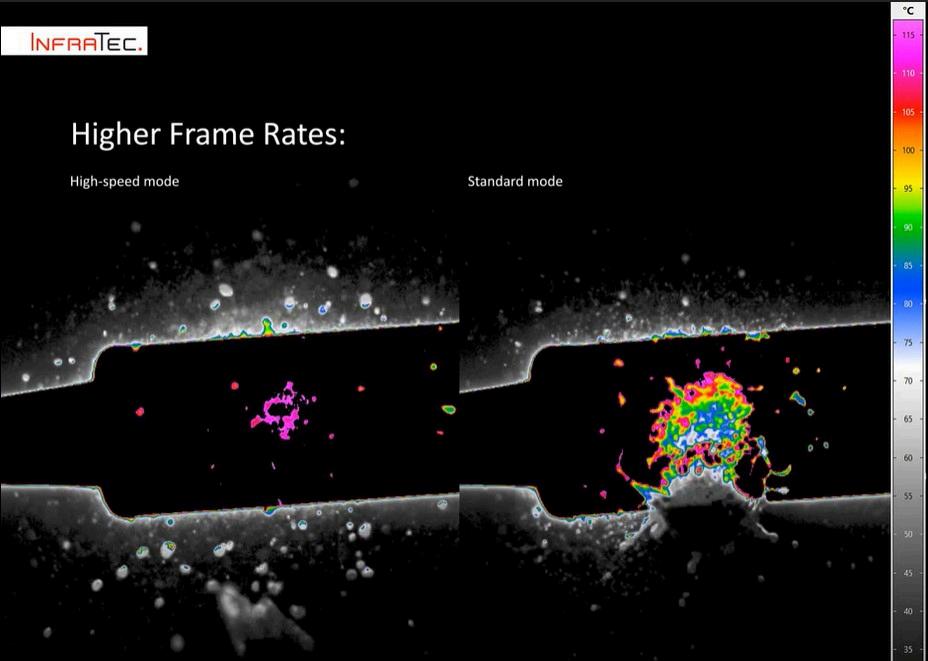
A NEWSLETTER FROM QUANTUM DESIGN UK AND IRELAND
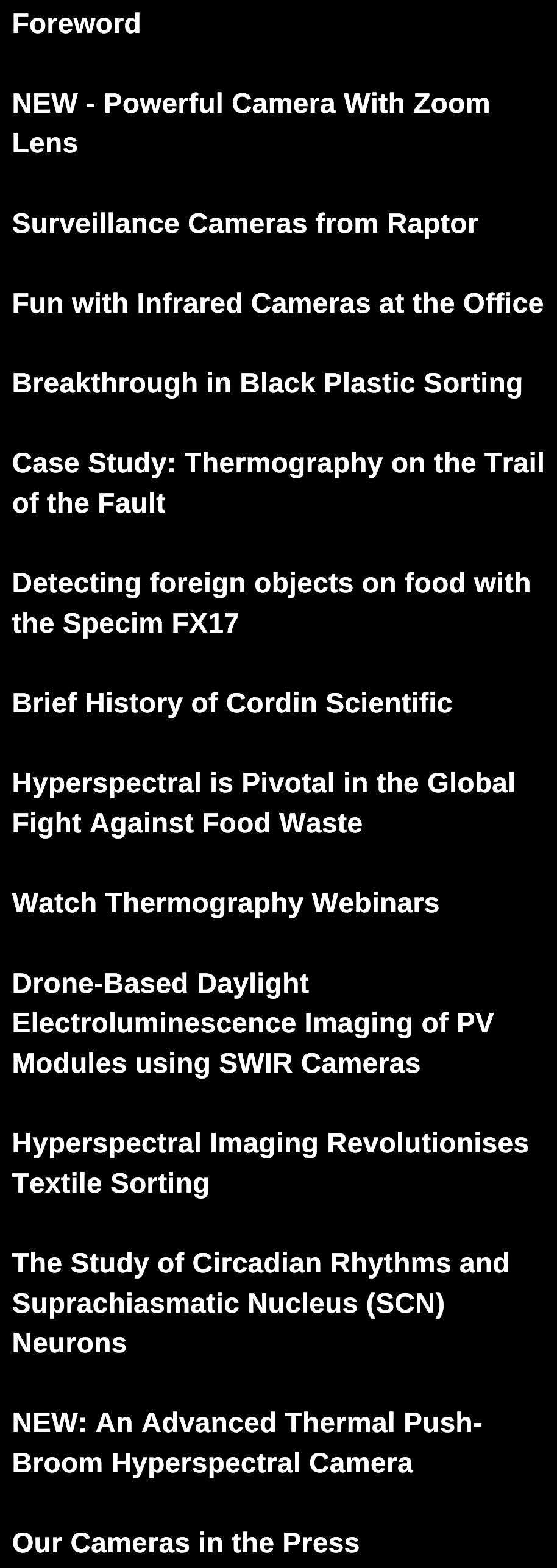
RAPTOR LAUNCHES RCMOS – CAMERAS RUGGEDISED FOR ANY ENVIRONMENT
Detecting Foreign Objects On Food With Hyperspectral
BREAKTHROUGH IN BLACK PLASTIC SORTING
Drone-Based Daylight Electroluminescence Imaging of PV Modules using SWIR Cameras
RENTAL CAMERAS AVAILABLE FOR YOU
Hyperspectral Imaging to Revolutionise Textile Sorting
CAMERAS
Contents Highlights


Quantum Design UK and Ireland (QDUKI) is proud to bring you the second edition of our Imaging Cameras magazine Packed with information about new products, case studies and application notes that have been produced using products that we offer
QDUKI has been involved with Imaging Cameras for 20 years as a distributor
We're particularly excited to announce that we have a range of rental cameras available for you to ‘try before you buy’ or simply use as a one-off for an upcoming research project. Cameras can be hired by the week or for a full month.
We can also look at hiring out the cameras for longer. There is no obligation to do so, but if you do go on to purchase the camera within 9 months of the rental, we will discount a portion of the selling price.
With all the new product launches, you might feel a bit overwhelmed by the choice, so please do get in touch with me for a chat about your requirements and application and I can help you select the perfect camera.
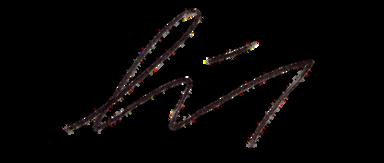 Luke Nicholls
CAMERA SALES ENGINEER
Luke Nicholls
CAMERA SALES ENGINEER
QUANTUM DESIGN UK AND IRELAND

Trade association memberships

WWW QD-UKI CO UK 04
OUR CAMERAS EXPERT: LUKE NICHOLLS
Technical Sales Manager
Luke joined Quantum Design a few years ago, following a Postdoc in the properties of complex beams at King’s College London in the Photonics & Nanotechnology group, headed by Prof Anatoly Zayats
Luke Nicholls started as our Camera Sales Engineer and is now our Technical Sales Manager.
He completed his PhD in Physics, also at King’s College London, with a thesis entitled “Controlling light with light: exploiting fast free-electron nonlinearities in plasmonic metamaterials for the control of light polarisation”.



His research experience in Photonics and Nanotechnology has helped customers across the Scientific and R&D market find camera solutions throughout the EM spectrum, from X-ray, through to visible and infrared, for their applications.
Luke has brought his wide ranging knowledge of optics to assist customers in providing solutions to their applications He looks forward to hearing from you about your next research project.
Luke is available for office/laboratory visits to talk through your application requirements, have a live seminar and/or to demonstrate the cameras Get in touch with Luke today to have a chat and book in your appointment:
 luke@qd-uki co uk
luke@qd-uki co uk
05
Luke at King’s College London, with their new Raptor camera, which will be used for Photonics and Metamaterials Research.
Luke and Stefan Keyser from InfraTec demonstrating the ImageIR at the Advanced Materials Show
Luke and Stefan Keyser training at the National Infrastructure Laboratory, University of Southampton with the InfraTec VarioCam

SEE MORE FOR GREATER FLEXIBILITY
The new ImageIR® 6300 Z expands the portfolio of powerful cameras with zoom lens

InfraTec has been developing infrared cameras for various industries and applications for years The product range includes amongst others the ImageIR® 8300 Z and ImageIR® 9300 Z cooled zoom infrared cameras with 30× high-performance zoom lens and autofocus function Both infrared cameras are ideally suited to defense research and surveillance activities
Both infrared cameras are ideally suited to defense research and surveillance activities The VarioCAM® HD Z complements these two models as an uncooled zoom thermal imaging camera in the long-wave infrared range and is used primarily for 24/7 operation in the industrial security sector.
InfraTec's latest zoom camera, which measures in the midinfrared range like its counterparts in the ImageIR® series, is now much smaller and easier to handle
Efficiency has a New Name – ImageIR® 6300 Z
The radiometrically calibrated ImageIR® 6300 Z uses a compact, robust SWaP (Size, Weight and Power) detector, which has been combined with a powerful zoom lens Capable of thermographic temperature measurement in various fields, this camera is designed for any user wanting to cover a broad, universal range of applications.
NO EXTENSIVE LENS CHANGE
The consistent use of the latest technologies in optics, detector and electronics is the basis for the remarkable user-friendliness of the camera series. The thermal imaging ImageIR® 6300 Z has a 7 5× zoom lens integrated as standard, which allows, in combination with the motorised focus, a fast and flexible adjustment to different object distances and sizes while maintaining stable image quality and high measurement accuracy
POWERFUL IMAGE PROCESSING ELECTRONICS
The ImageIR® 6300 Z has high-performance image processing electronics and can output the IR image data in real time to several video and data interfaces as well as record and evaluate it autonomously This camera can also be operated via smartphone or tablet using its web interface. With these features and the possibility to power it from an external battery, this camera is ready for mobile outdoor use The zoom camera can be easily integrated into existing system environments in a space-saving way. It is suitable for universal use in research and development, but also for integration into GIMBAL systems in the field of flight thermography
DETECT SMALLEST TEMPERATURE DIFFERENCES USING HIGH THERMAL RESOLUTION OF 30 MK
The thermal resolution of the ImageIR® infrared camera series allows you to measure smallest temperature differences of better than 0.03 K (at 30 °C).
Thermal images with a narrow temperature span display details absolutely sharp You will find interesting signatures even there where other infrared camera systems cannot detect any temperature differences any longer

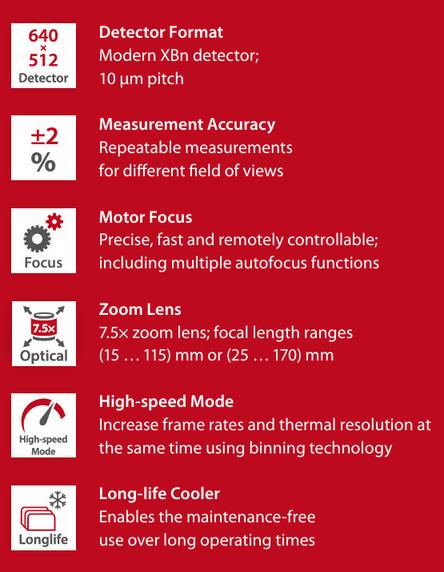
HIGH-SPEED MODE TO INCREASE FRAME RATES AND THERMAL RESOLUTION AT THE SAME TIME
If you want to analyse the thermal behavior of objects and processes from a wide variety of perspectives, you can use the high-speed mode for maximum flexibility This function allows the camera to be used in two different operating modes. The standard mode suits best for depicting the smallest geometrical details. This allows users to record images with the native number of pixel of the camera detector Switching to high-speed mode opens up the option of more than triple the frame rate, while the field of view (FOV) remains identical. This enables for most accurate time monitoring of fast processes At the same time, the thermal resolution increases by a factor of 2 in high-speed mode, which additionally improves the analysis of temperature differences.
WWW QD-UKI CO UK 07


Broad Range of Applications
The ImageIR® 6300 Z is designed specifically for challenging applications and can be easily integrated into existing system environments in order to save space This zoom camera's extreme flexibility – even for close-range applications – makes it the ideal solution for numerous measuring and inspection tasks
Fields of application:
Research and development
Aerial thermography: inspection and monitoring tasks
Quality assurance
Materials testing
Integration solutions




WWW QD-UKI CO UK 08
find out more
NEVER MISS ANOTHER UPDATE
Here at Quantum Design UK and Ireland, we only want to send you the information that you would like to see. When filling out the form, please tick the particular fields and product suppliers that interest you, and we will make sure you are kept up to date with ONLY the most relevant information. join our newsletter




EX-DEMO AFX17
UP FOR GRABS

We are excited to be able to offer an ex-demo Specim AFX17 airborne spectral imaging camera at a 50% discount. The AFX series is a hyperspectral solution based on the successful FX Series
The Specim AFX17 is a powerful tool for remote sensing and analysis, allowing for accurate and detailed insights into the spectral properties of a scene. find out more
PHalf rice
S U R V E I L L A N C E
C A M E R A S
F R O M



FLIGHT-READY HAWK 247 EMCCD OEM CAMERA

WWW QD-UKI CO UK 10
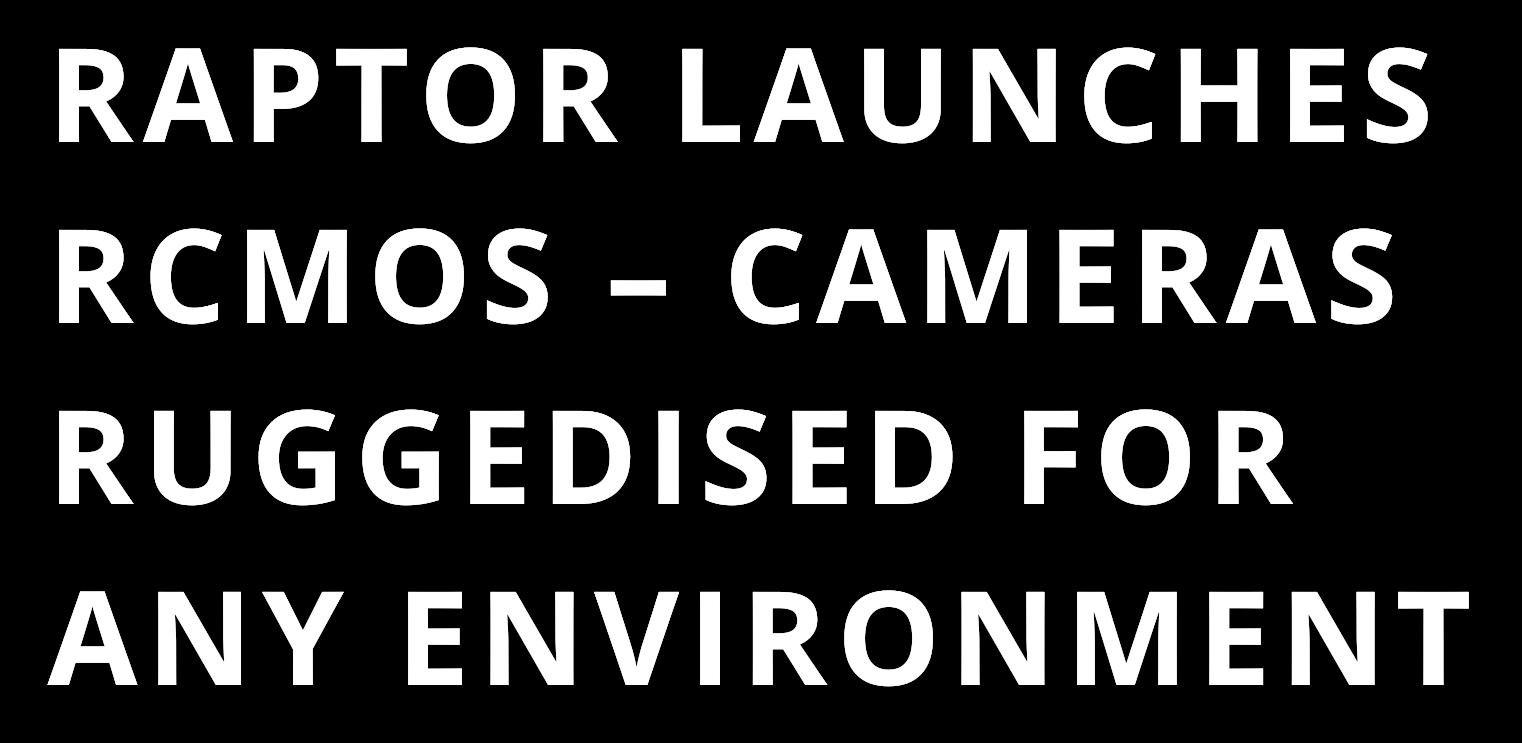

Raptor has launched a family of ruggedised CMOS cameras. The Hawk series of ultrasensitive RCMOS OEM cameras cover UV, VIS and NIR wavelengths and are designed to reliably perform in the harshest conditions from the seabed to space, withstanding temperature, pressure, moisture, radiation, shock and vibration extremes
Available in a range of resolutions, the Hawk cameras are perfect for the most demanding conditions for airborne, space, surveillance, industrial and marine applications.
find out more
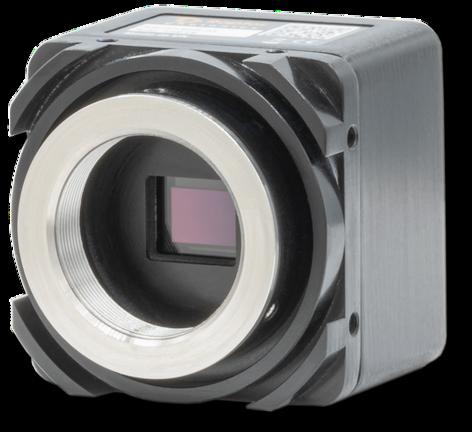

Applications
Surveillance
Low-light Surveillance
Airborne Surveillance
Driver Vision Enhancement (DVE)
Digital Night Vision
Ground Based Surveillance
Embedded Vision
Plastics / PET Semiconductor Inspection

Space
Docking
Navigation
Space Situational Awareness
Inspection
Hyperspectral Imaging
Earth Observation

WWW QD-UKI CO UK 11

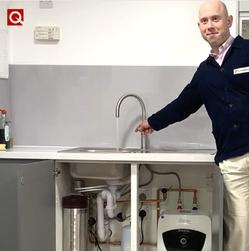


Firstly,
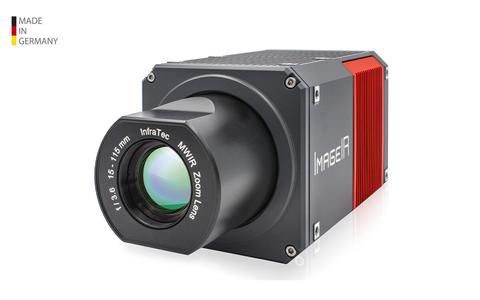



and a spare ten minutes...


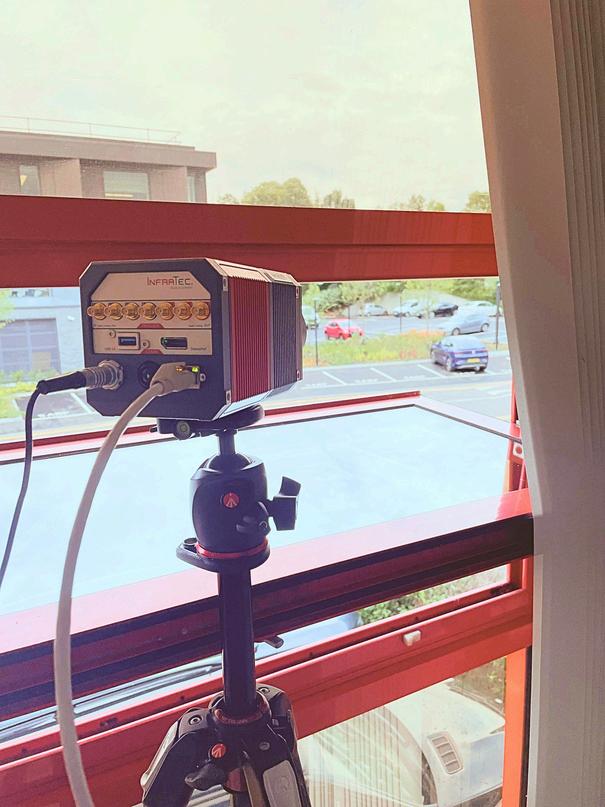
Smaller, lightweight, without tedious lens changes –efficiency has a new name: The ImageIR®6300Z with a powerful zoom lens and a SWaP detector


WEPLAYEDHIDEANDSEEK
InfraTecImageIR
aQuookertap HereatQuantumDesignUKandIreland WEHAD
InfraTec Rcamera
withan
6300Zcamera
cold tap inthecar park Then hot tap And then the steamy Quooker! then...


Black plastics are everywhere; cars, vehicles, electronics, packaging, and plastic bags. Instead of recycling, they are burned for energy or dumped in a landfill since efficient and reliable technology has not been available to sort black plastics – until now.
Hyperspectral imaging is the only technology capable of sorting different black plastic types when used on the MWIR spectral range.
Specim announces the upgraded Specim FX50 middle-wave infrared (MWIR) hyperspectral camera. The Specim FX50 is the first and only push-broom hyperspectral camera on the market that covers the full MWIR spectral range of 2 7 – 5.3 μm.
Specim FX50 allows fast and reliable sorting of:
Black plastics such as PS, PE, PP, ABS and PVC
Rubbers
Non-black plastics and rubbers
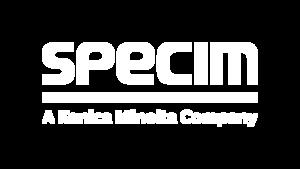
This breakthrough product with enhanced features and capabilities expands the possibilities in industrial sorting, quality control, process optimisation, and research by detecting materials that are not detectable with any other wavelength or imaging method, such as hydrocarbons, minerals, oil, and contamination on metal surfaces.
“The launch of the improved Specim FX50 marks a significant milestone for Specim and our customers. The first version of the camera was released in 2019 and its demand exceeded our expectations, and we’re excited about the untapped possibilities this camera offers.”
Tapio Kallonen, CEO at Specim
WWW QD-UKI CO UK 13

The new Specim FX50 drives cost efficiency and sustainability by enabling efficient raw material detection, manufacturing, and identifying valuable materials worth recovering for recycling and reuse. In particular, it revolutionises the field of black plastic sorting, as it is the only product with the required wavelength range capable of sorting difficult black plastics
“One remarkable benefit of the Specim FX50 is its game-changing impact on black plastic sorting. The FX50 camera enables the identification and separation of black plastics effectively, helping to boost the efficiency, accuracy, and profitability of the crucial process,”
Tapio Kallonen, CEO at Specim
find out more
THE NEW SPECIM FX50 OPENS DOORS TO NEW OPPORTUNITIES FOR SCIENTIFIC EXPLORATION.
Accurate Inspection and Robust Industrial Design
With a high spatial resolution, image speed, and enhanced signal-to-noise ratio, the Specim FX50 enables fast and accurate inspection and classification of materials with very similar spectral features.
Beyond its impressive spectral capabilities, the Specim FX50 boasts new optimised thermal management that maximises sensor lifespan and minimises downtime, leading to increased operational efficiency and cost savings.
In addition, the Specim FX50 offers several notable benefits, including temperaturestabilised optics, built-in image correction capabilities, unified spectral calibration between units, and a standard GigE Vision interface. These features improve the performance and reliability of the camera and ensure easy integration into industrial environments
14
CASE STUDY:


This method is also used for research purposes at the Institute for Electrical Systems and Energy Logistics at BTU Cottbus-Senftenberg. In this context, Prof. Dr. Ralph Schacht is intensively involved with the material and system characterisation as well as the non-destructive failure analysis of printed circuit boards, electronic components, microelectronics as well as composite systems of packaging and interconnection technology
Non-destructive testing (NDT) – in contrast to destructive component testing – implies that the test application must not influence or reduce the usability of the test object in any way. Thermal imaging is a non-destructive, very efficient method. It enables the imaging detection of thermal radiation as well as the interpretation of the observed surface temperatures
At the Institute of Electrical Systems and Energy Logistics at the BTU CottbusSenftenberg, non-destructive component testing is carried out using various thermography methods: passive IR thermography, active IR pulse thermography and active IR lock-in thermography.
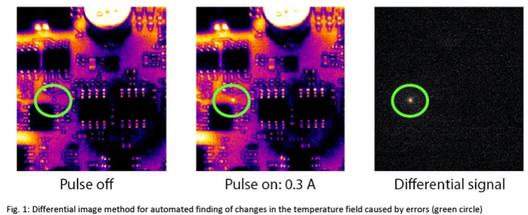
The infrared camera used for this purpose is the ImageIR® 8300 from InfraTec with a M=3x magnification microscope lens or a macro attachment The measurements are evaluated with the IRBIS® 3 thermography software belonging to the camera and the additional module IRBIS® 3 active.
Passive IR Thermography
With this method, electrical "short-circuit currents" are selectively injected into the assemblies to be tested This can lead to increased current flows in faulty areas, which in some cases trigger the slightest temperature changes there and can be detected using thermography Short-circuit tests of electrical through-hole platings in printed circuit boards serve as an example here Due to the possibility of evaluating the differential image within the IRBIS® 3 thermography software, the contact point can be precisely localised in real time (Fig. 1).


WWW QD-UKI CO UK 15
Fig 1. Differential image method for automated finding of changes in the temperature field caused by errors (green circle)
The utilisation of, for example, power MOSFETs in 3-phase inverter operation can also be displayed and monitored very well using this method (Fig 2) With the aid of the high-resolution M=3x microscope lenses used on the ImageIR® 8300 infrared camera, it is possible to characterise integrated passive components at wafer level. The thermal behaviour of nickel-chromium resistors as a function of their power dissipation was analysed here (Fig 3)

operation
Active IR Pulse Thermography
This form of non-destructive testing is a frequently used method to detect hidden damage in components Heat is pulsed into a sample while the temperature field of the stimulated surface is observed in parallel.
This enables the evaluation of both heating and cooling curves The advantage of impulse thermography is its high speed and, as a result, the high potential for a 100 percent inspection during a production process.
Using this method, it is possible to take advantage of the fact that locally different cooling processes occur after the excitation impulse. The time of the maximum temperature difference and the difference as such are determined
This method also allows conclusions to be drawn about structures that are not directly located on the component surface (Fig. 4).

Fig. 4 Left: General temperature curves on the surface above a material inhomogeneity T2 and above an undisturbed area T1. At a certain time T , a maximum temperature difference dT and a maximum in the contrast curve can be observed. Right: below T2 there is a defect in the material structure at a depth z.
Practical examples of this measurement method can be seen in connection with the assembly of power semiconductors Delaminations in a solder layer after cyclic loading or the propagation of crack fronts in sintered layers can, for example, be detected
Active IR Lock-In Thermography
The lock-in principle or lock-in amplification is employed when a useful signal is to be found in a statistically noisy overall signal. This must be periodically amplitudemodulated in a targeted manner.
 Fig 2. Analysis of the dynamic temperature behaviour of MOFSET modules in 3-phase alternating
Fig.3 Characterisation of integrated passive NiCr resistors on a flip-chip substrate; Left: Measurement setup Right: IR image
Fig 2. Analysis of the dynamic temperature behaviour of MOFSET modules in 3-phase alternating
Fig.3 Characterisation of integrated passive NiCr resistors on a flip-chip substrate; Left: Measurement setup Right: IR image
WWW QD-UKI CO UK 16
max max
In the simplest case, this is done by switching the supply voltage of an electronic component on and off or by sinusoidal modulation
In addition, this method allows very small and weak heat signals to be detected Taking, for example, a test structure with a 50 µm small diode and exciting it with 10 mW at 0.1 Hz (duty cycle 50 %), the sought-after measurement signal in the pure thermal image is below the detection limit However, the power dissipation source can be localised very clearly via a generated amplitude image – even in real time using the IRBIS® 3 active thermography software.

Fig.5 Top: PT analyses on a sintered MOSFET transistor at three points in time during a temperature cycling test (after 0, 150, 300 temperature changes). Bottom: SAM images after 0 and 300 temperature changes as reference

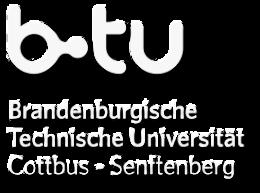
The BTU Cottbus-Senftenberg has been using the ImageIR® 8300 for the measurements presented here for several years. This camera is equipped with a 25 mm standard lens as well as M=1x and M=3x magnification microscope lenses. Internally, two filteraperture wheels have also been installed, a unique feature of the camera series, with which both signalattenuating filters and spectral filters can be swivelled in remotely in parallel In addition to the high spatial resolution of this system, excellent measurement accuracies are also achievable with each lens, so that exact and repeatable results are obtained.
The associated IRBIS® 3 active software allows, among other things, convenient data evaluation options of image sequences, the calculation of phase and amplitude images as well as the analysis with various methods of active thermography. These include, for example, the quotient method, pulse phase and lock-in thermography
The ImageIR® 8300, including its software tools, has become an indispensable aid in scientific training as well as in research work at the institute.
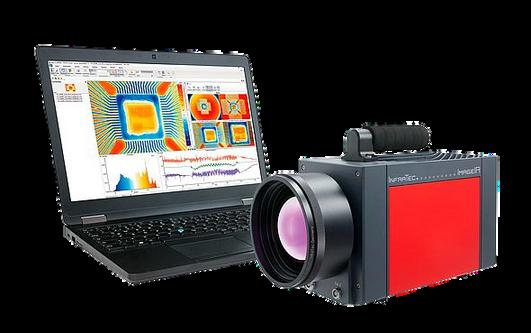
luke@qd uki.co.uk
RENTAL HIGH SPEED THERMOGRAPHY SYSTEM FOR YOUR RESEARCH PROJECT available WWW QD-UKI CO UK 17
RENTAL
find out more


To ensure the quality and safety of food products, manufacturers must implement robust quality assurance throughout the production process, where hyperspectral imaging offers a solution
In this study, the Specim FX17 hyperspectral camera (900 – 1700 nm) and Specim Lab Scanner 40*20 were used to measure three food products: chicken fillet, veggie patties, and goat cheese containing contaminants. Foreign objects were placed on each food product with the aim of creating a classification model to detect those.



First up, the chicken fillet, a valuable food product Contaminants used were wood, metal, and two kinds of plastics (PE and PS). The food was placed on baking paper.
Figure 2 shows the measured chicken fillet with and without the contaminants.

After this, they examined the veggie patties using the same contaminants as those used for the chicken fillet (Fig 3).
Fig 1. Scanning the chicken fillet with the Specim FX17 camera and LabScanner 40×20.
18
Fig 2. Chicken fillet with contaminants. Photos (left) and hyperspectral false RGB image (right).
FOREIGN OBJECTS IN FOOD POSE SIGNIFICANT RISKS TO CONSUMER SAFETY. THE DISCOVERY OF FOREIGN OBJECTS OFTEN RESULTS IN PRODUCT RECALLS, WHICH CAN BE COSTLY FOR BUSINESSES AND DAMAGE THE BRAND’S REPUTATION.


Finally, the goat cheese was measured. Specim used a piece of packaging material, i.e., a small piece of thin white plastic wrapping, as a contaminant. Figure 4 shows that the contaminant looks very similar to the cheese and is hardly visible with an RGB camera or the naked eye.

SPECTRAL
COMPARISON BETWEEN FOOD AND FOREIGN OBJECTS
Each data was normalised with respect to white and dark references We processed the resulting reflectance data with the SpecimINSIGHT analysis software Area selection from the chicken fillet and contaminants were taken, and a mean spectrum from each selection was drawn to the spectral plot for comparison (Fig 5).
The colour of each spectra matches the colour of the corresponding selection on the image. The spectral plot shows that the spectral signatures of the chicken fillet and all the contaminants are clearly different.
The spectral signature of the veggie patties also differs from the contaminants, as shown in Figure 6.

The goat cheese packaging material is slightly transparent, which causes the spectrum of the goat cheese to mix with the spectrum of the packaging material (Figure 7). Therefore, the spectral signatures of the goat cheese and the contaminant don’t differ as significantly as they do with the chicken fillet and veggie patties and the contaminants.
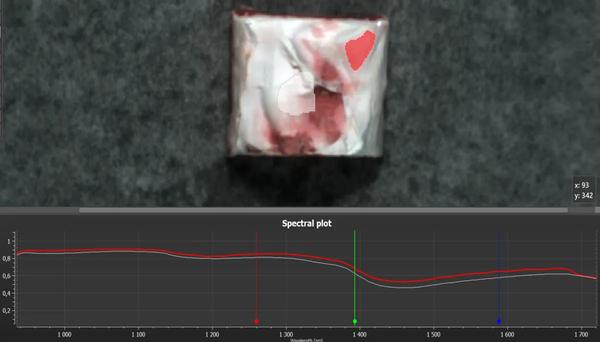 Fig 3. Veggie patties with contaminants. Photo (left) and hyperspectral false RGB image (right)
Fig 4. Goat cheese with contaminant. Photo (left) and hyperspectral false RGB image (right).
Fig 5. Spectral comparison of the chicken fillet and the contaminants. Chicken = light brown, PS = red, PE = purple, wood = yellow), metal = green.
Fig 6. Spectral comparison of veggie patties and contaminants. Vegetable steak = brown, PS = red, PE = purple, wood = yellow, metal = green.
Fig 7. Spectral comparison of goat cheese and contaminant. Goat cheese = white, packaging material = red.
Fig 3. Veggie patties with contaminants. Photo (left) and hyperspectral false RGB image (right)
Fig 4. Goat cheese with contaminant. Photo (left) and hyperspectral false RGB image (right).
Fig 5. Spectral comparison of the chicken fillet and the contaminants. Chicken = light brown, PS = red, PE = purple, wood = yellow), metal = green.
Fig 6. Spectral comparison of veggie patties and contaminants. Vegetable steak = brown, PS = red, PE = purple, wood = yellow, metal = green.
Fig 7. Spectral comparison of goat cheese and contaminant. Goat cheese = white, packaging material = red.
CLASSIFICATION
APLS-DA model(*) was created for each food product to detect foreign objects. Models for chicken fillet (Fig 8) and veggie patties (Fig 9) both include five classes (PE, PS, wood, metal, and food). The goat cheese contains only one contaminant, so the classification model (Fig 10) includes only two classes (plastic and food). Each model’s background is detected and visualised with a black colour.
*PLS DA = PARTIAL LEAST SQUARE DISCRIMINANT ANALYSIS



CONCLUSION
This study used a Specim FX17 hyperspectral camera (900 – 1700 nm) to detect foreign objects on food products. Based on the measurement and analysis, we can conclude:
Spectral signatures of food products and contaminants are distinguishable
Based on data captured with the Specim FX17 camera, creating a classification model to detect contaminants is possible.
The Specim FX17 hyperspectral camera can detect contaminants that are invisible to the human eye and undetectable with a standard RGB camera

luke@qd-uki.co.uk WWW QD-UKI CO UK 20
Fig 8. Chicken fillet with contaminants: PS=red, PE=purple, wood=yellow), metal=green
Fig 9. Veggie patties with contaminants: PS=red, PE=purple, wood=yellow), metal=green.
Fig 10. Goat cheese with contaminant. The piece of packaging material=red.
RENTAL available


Cordin is a family owned high technology design and manufacturing firm located in Salt Lake City, Utah specialised in ultra high speed cameras for scientific research.

Manhattan Project
During the Manhattan project, a tricky technical problem emerged regarding energy levels of the conventional explosive stage of the first nuclear weapon There was acute disagreement between the explosives experts and the physicists as to what exactly the problem was

A gifted technician on the project named Berlin Brixner had the idea to take a high speed picture He was familiar with the work of Cearcy D. Miller, who had demonstrated the principle of relaying an image at high speeds through a rotating mirror in the 1930's
They built the first ultra-high speed rotating mirror camera, capable of 1 million frames per second They photographed their experiments, and the pictures revealed timing errors in detonation which neither the ballistics experts nor the physicists had anticipated. This was the last major technical hurdle of this history changing project, solved by the ultra high speed camera
The Beginnings
The technology remained classified for around ten years It was declassified and presented at a conference in 1953, attended by Earl Pound, who was a professor at the University of Utah He and Bill Partridge formed Cordin Company in 1956 and built a camera for a local explosives manufacturing company. The name Cordin was taken from 'coordination', symbolic of the coordination between government, academia and private enterprise which created the company
WWW QD-UKI CO UK 21
Since its inception, Cordin has always pursued the highest quality and sophistication of high speed imaging devices. In 1982, it began offering image converter cameras. And in 1994, the company began offering high speed imaging using CCD technology In 2004, it began the migration away from film to CCDs for the rotating mirror camera systems. Cordin products from these three major product lines have been purchased by leading research centers worldwide
Cordin’s customer base has expanded from military and explosives research facilities to include a very broad array, including many of the research leaders in:



material science aerodynamics, hydrodynamics, internal combustion engines laser studies, medical research
find out more


Cordin continues to look toward the future by staying at the forefront of imaging technology Throughout its history, Cordin’s basic commitment has not changed That commitment is to provide intelligent, competent solutions to fill customers’ needs in high speed and high technology imaging devices It is through this commitment that Cordin has developed and maintained an undisputed leadership in their field.
Applications






WWW QD-UKI CO UK 22
RENTAL available
Rent the Specim IQ Hyperspectral camera for a week or a month at a time for your next research project at competitive rates.
Lightweight | Portable | Compact
luke@qd-uki.co.uk

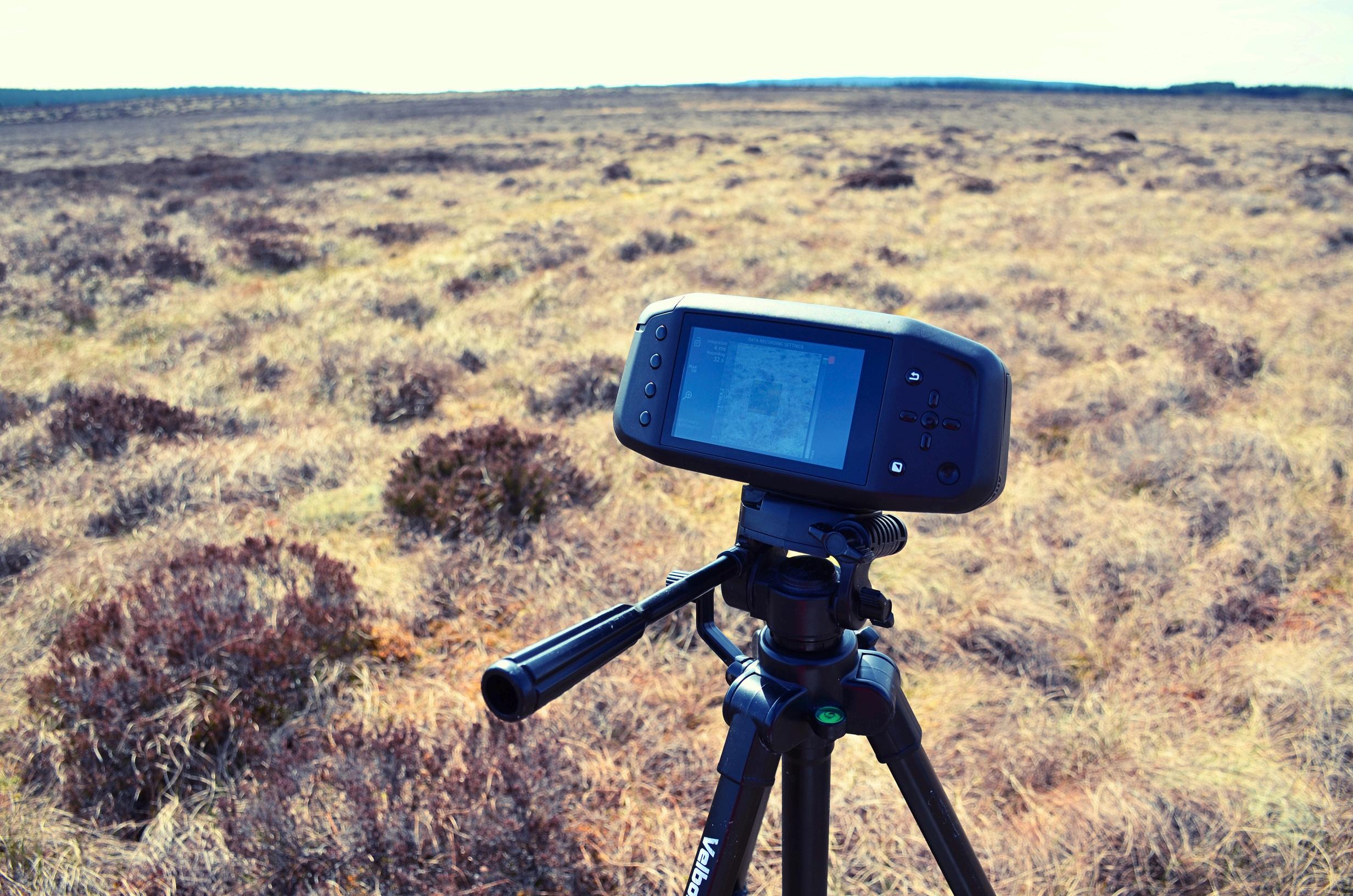
At Quantum Design UK & Ireland, we try to attend all the top industry events, conferences, and symposiums. That way we can be available for discussions on the products we offer.
If you’re there, pop by to see demo models and chat about your upcoming research projects and applications
upcoming events
find out more



H A R N E S S I N G
H Y P E R S P E C T R A L
I M A G I N G : A P I V O T A L
P L A Y E R I N

Food waste is a global challenge that demands immediate attention. Shockingly, approximately one-third of all food produced for human consumption is wasted annually, according to the United Nations.
This staggering waste represents a colossal economic loss and carries severe environmental and social consequences. In the ongoing battle against food waste, technology has emerged as a potent ally, and one of its most promising champions is hyperspectral imaging.
Revealing the Invisible
Hyperspectral imaging takes us beyond the limits of human perception It grants us access to the unseen, unveiling the molecular composition of food. This innovative technology collects data across the electromagnetic spectrum, exposing hidden intricacies that remain invisible to the naked eye.
At its core, hyperspectral imaging allows us to capture and analyse the unique spectral signatures of various materials This ability is particularly useful in the agricultural sector, where it can help identify and sort fruits and vegetables based on their ripeness, quality, and potential for spoilage.
luke@qd-uki co uk
By doing so, farmers and distributors can make more informed decisions on managing their produce and reducing unnecessary waste.
Early Spoilage Detection
One of the standout advantages of hyperspectral imaging is its capacity to spot spoilage at its earliest stages. It can discern minute alterations in the spectral signatures of food items, allowing for the identification of spoilage or contamination before visible signs manifest. This early detection is instrumental in averting the distribution and consumption of unsafe or substandard food products.

A Catalyst for Research and Innovation
Hyperspectral imaging continues beyond waste reduction. It catalyses ongoing research, driving innovation and offering new perspectives on tackling the global challenge of food waste
In conclusion, hyperspectral imaging is a powerful weapon in the crusade against food waste. Its ability to elevate food quality, avert spoilage, and enhance the efficiency of the food supply chain positions it as a transformative force in the pursuit of a more sustainable and wastefree future.
T H E G L O B A L F I G H T A G A I N S T F O O D W A S T E

MEASURING THE AGEING OF PLUMS AND TOMATOES WITH SPECIM FX10
HYPERSPECTRAL
CAMERA
Food ageing is an important parameter to be quantified when evaluating freshness.
In this study, we used the Specim FX10 hyperspectral camera and a lab scanner to inspect plums and tomatoes for 20 days to assess the aging process (Fig 1).
The Specim FX10 is a visible-near infrared (VNIR) camera that covers the spectral range from 400 to 1000 nanometers. The first part of the analysis focuses on the spectral features of the samples over time. Then, a regression model of tomatoes’ and plums’ ageing is presented.
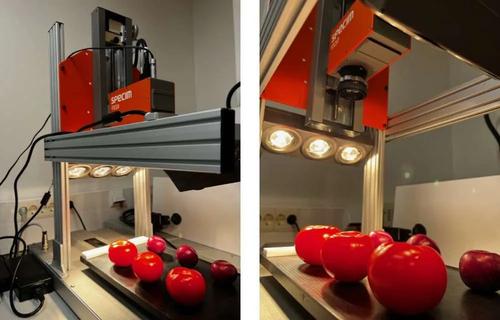
Photos of the samples were taken, along with the hyperspectral data. The pictures show that the freshness of the plums, especially the tomatoes, degraded firmly over time (Fig 2). A small cut was made in the middle of one tomato and plum. It seemed to have a substantial impact on accelerating the ageing of the tomato but not on the plum.
Spectral reflectance reveal chemical changes
A rectangular selection was made on each plum and tomato each day when the spectral measurements were made (1st, 2nd, 3rd, 6th, 9th, 13th, 14th, 16th, 17th, and 20th day). Only the spectra obtained on the 1st, 13th, and 20th day are presented in Figure 3 to ease the reading of the results. Spectra are averaged over the selection.

The spectral differences are more significant for the tomatoes than for the plums. This is already visible in the photos taken on the 1st, 13th, and 20th days (Fig 2).
The spectra reveal chemical changes which happen over time within the fruits and vegetables. Plums and tomatoes are green at early growing stages due to the chlorophyll they contain. But when ripening, the chlorophyll breaks down into another chemical. For tomatoes, chlorophyll breaks down into lycopene, which explains the red colour. This chemical change explains the spectral variation of the plums and tomatoes over time between 550 and 750 nanometers. The ripening process of the fruits and vegetables also affects the moisture level or structure, impacting their spectra at 970 nanometers. Other properties (e.g., sugar content) also change over time, shaping the spectral reflectance.
 Fig 1: A sample of three plums and tomatoes placed on a lab scanner 40×20 and measured with a Specim FX10 camera for 20 days.
Fig 2 Photos of the samples taken on the 1st, 13th, and 20th day
Fig 1: A sample of three plums and tomatoes placed on a lab scanner 40×20 and measured with a Specim FX10 camera for 20 days.
Fig 2 Photos of the samples taken on the 1st, 13th, and 20th day
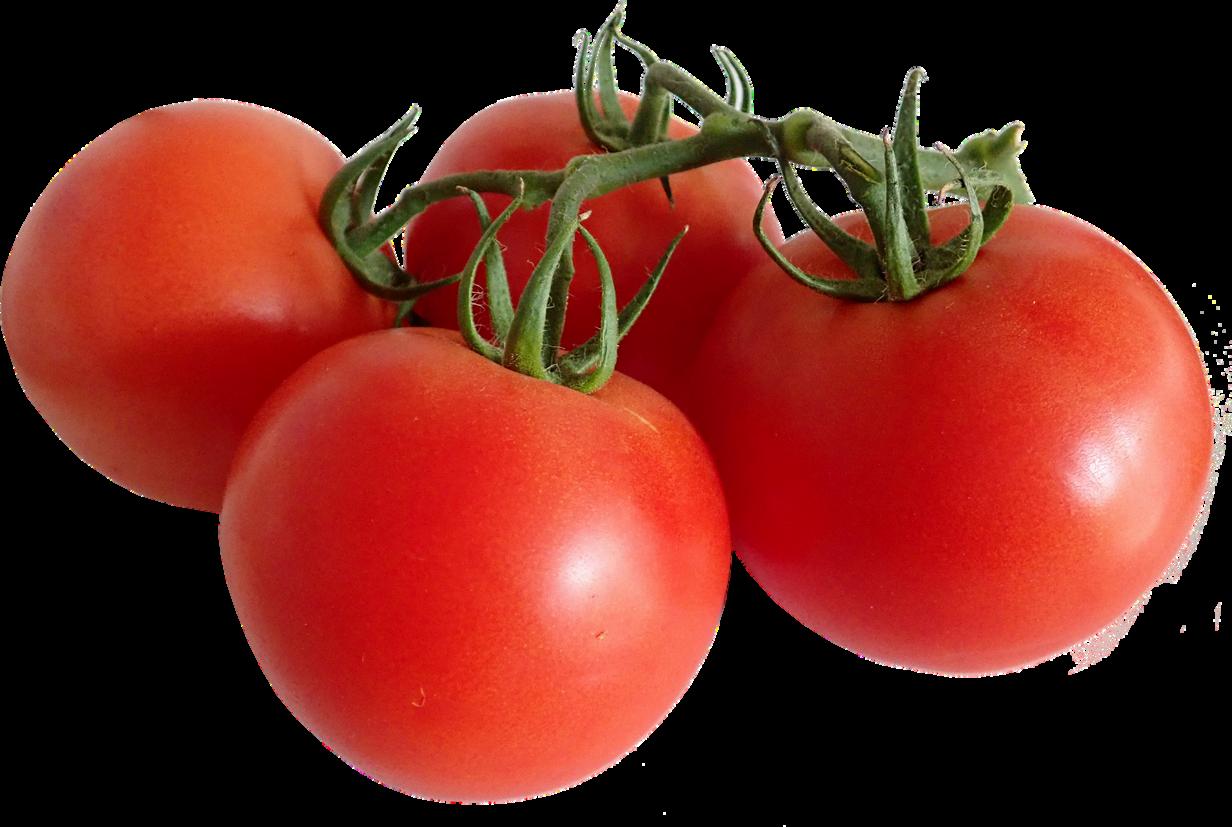
Regression model to quantify the ageing
A regression model was built to quantify the ageing of the plums and tomatoes (Fig 3). The imaging day was the actual regression variable.
With the plums, the R2 was 0.81, whereas, for the tomatoes, it was 0.91. Those were computed on other selections than those used to train the model. The regression graph of Actual value vs. Predictions is presented in Fig 4.



For the plums, the model was based on the reduced spectral range from 588 to 976 nanometers. For the tomatoes, the model was based on the spectral bands between 445 and 993 nanometers.
Conclusion
The Specim FX10 camera is suitable for measuring fruits and vegetables’ ripeness and ageing as it is sensitive to traits related to freshness for agri-food products. When building a typical regression model, laboratory measurements should be used as a reference value to develop and validate the model. However, those are not needed for accessing fruits and vegetables’ ageing.
Hyperspectral cameras operating in visible-near infrared (VNIR) provide an efficient tool for monitoring the product quality of fresh food products. Hyperspectral imaging is an especially suitable method for food grading, sorting, and classification compared to conventional pointbased methods due to its non-destructive nature.

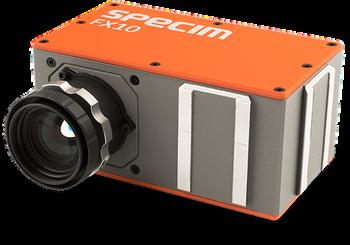

luke@qd-uki co RENTAL available
26
Fig 3: False RGB images of the plum and tomatoes acquired on the 1st, 2nd, 3rd, 6th, 9th, 13th, 14th, 16th, 17th, and 20th day Each dataset was combined into a single one (mosaic), from the left (1st day) to the right (20th day) Averaged spectra for each tomato and plum are displayed on the 1st day (white), 13th day (pink), and 20th day (purple).
Fig 4: Regression model output on the three plums (top) and three tomatoes (bottom) Data were acquired on the 1st, 2nd, 3rd, 6th, 9th, 13th, 14th, 16th, 17th, and 20th day (from left to right). The heat map ranges from the 1st day (Min) to 25th day (Max)
Fig 5: Actual values vs model predictions for both models (measuring the ageing of plums and tomatoes)
find out more
WATCH THERMOGRAPHY WEBINARS

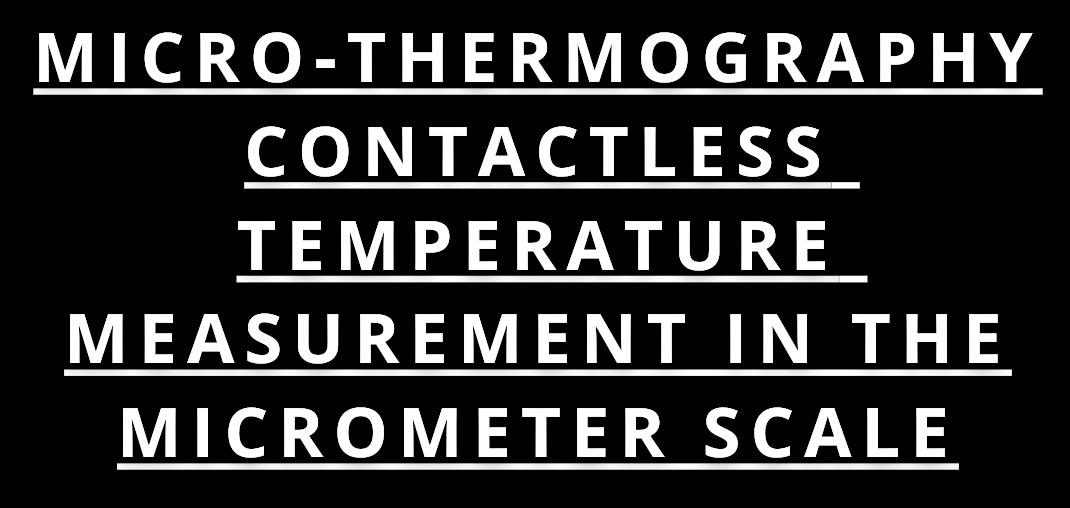



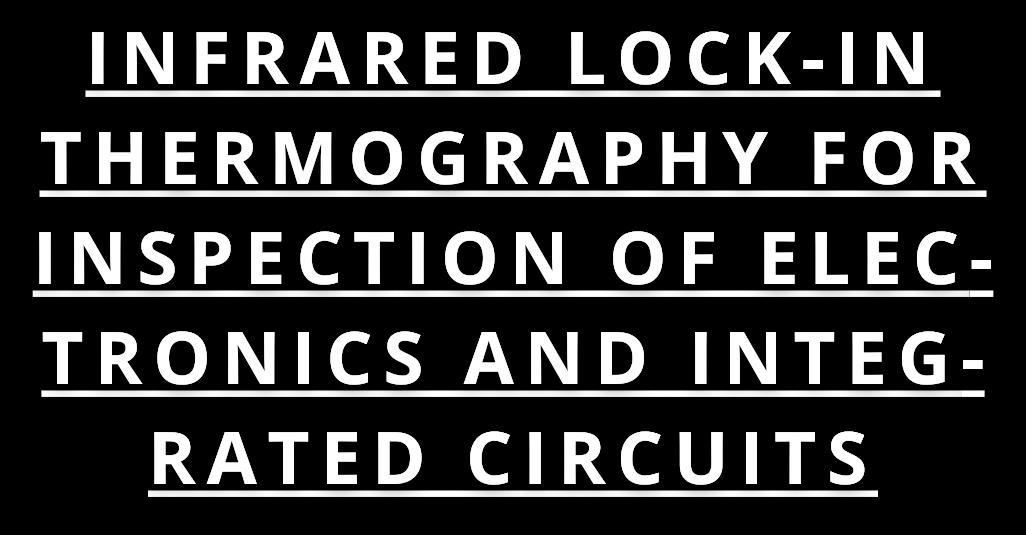

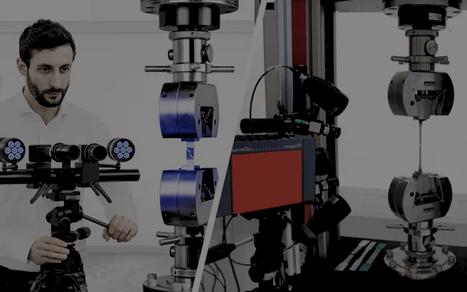




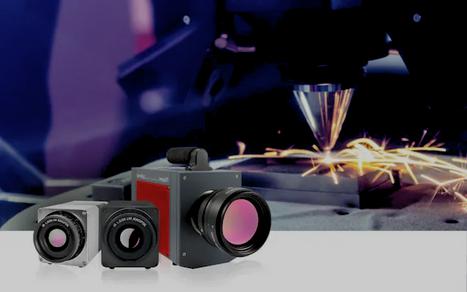

Don't miss out on the best webinars - watch them now WWW QD-UKI CO UK 27


Electroluminescence (EL) imaging of photovoltaic (PV) solar panels provides high accuracy in detecting defects and faults, such as cracks, broken cells, interconnections, shunts, among many others; furthermore, the EL technique is used extensively due to a high level of detail and direct relationship to injected carrier density.
This technique is commonly practiced only indoors - or outdoors from dusk to dawnbecause the crystalline silicon luminescence signal is several orders of magnitude lower than sunlight. This limits the potential of such a powerful technique to be used in utility scale inspections, and therefore, the interest in the development of electrical biasing tools to make outdoor EL imaging truly fast and efficient.
A team at Technical University of Denmark (DTU) lead by Gisele Alves dos Reis Benatto and Peter Behrensdorff Poulsen have used a drone-based system capable of acquiring EL images using an Owl 640 SWIR camera, running at a frame rate of 120 frames per second and imaging in the 1125-1175nm range In a single second during high irradiance conditions, this system

can capture enough EL and background image pairs to create an EL PV module image that has sufficient diagnostic information to identify faults associated with power loss. See Figure 1. Figure 2 highlights the Signal and sensor involved in daylight EL imaging.

WWW QD-UKI CO UK 28
Fig 1: Drone with Raptor 640 SWIR camera
Fig 2: Signal and sensor involved in daylight EL imaging.
Figure 3i highlights drone based EL images, acquired with global horizontal solar irradiance close to one sun in the plane of the array, where one sun equals 1000W m2.


With further work on the algorithms, this technique shows much promise. It is an obvious advantage to use a drone to inspect PV modules on a solar farm during daylight hours.
When the drone starts to fly overhead, you can see further EL images shown in figure 3ii It shows images with DC modulation (c) and AC & DC modulation (d). It presents lower quality compared to those obtained indoors and stationary in daylight in figure 3i, but still having sufficient quality to identify the main features related to the module power loss.


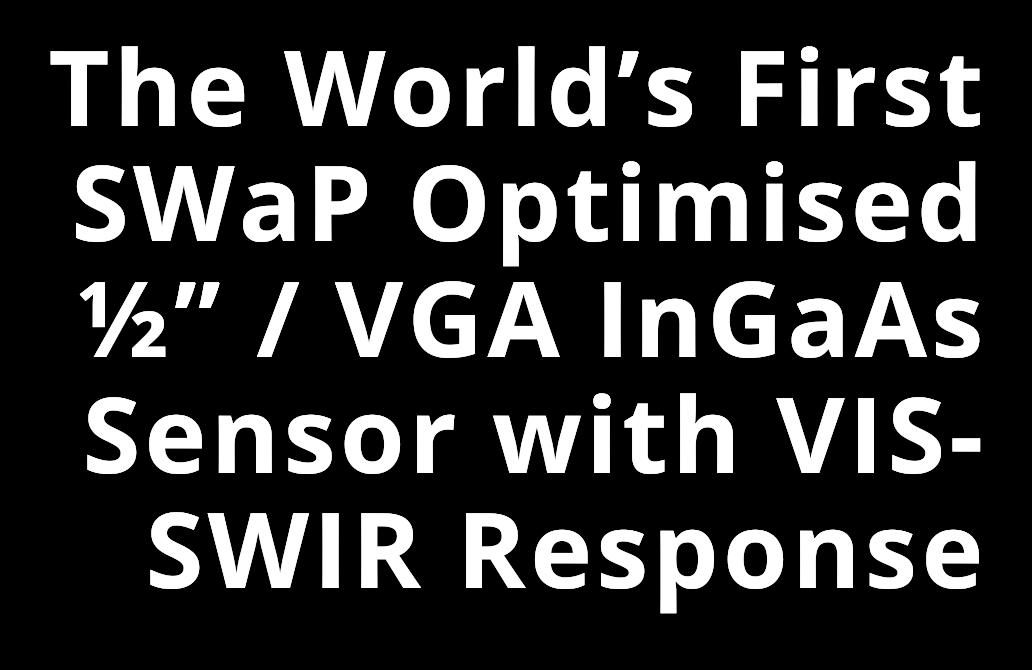
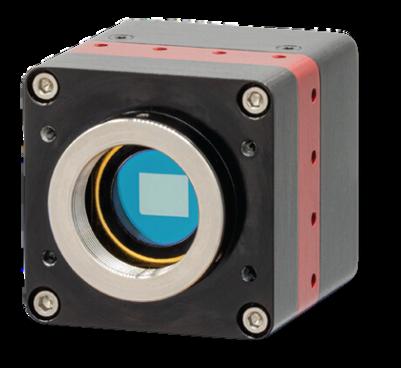
VIS-SWIR technology Enables high
sensitivity imaging from 0 9μm to 1 7μm
High quality sensors 99.5% operability, 640x512, 15μm pixel pitch
15μm x 15μm pixel pitch Enables highest resolution VIS-SWIR image
Ultra high intrascene dynamic range
Enables simultaneous capture of bright & dark portions of a scene
On-board Automated Gain Control (AGC)
Enables clear video in all light conditions
Ultra compact, Low power Ideal for handheld, mobile or airborne systems
Figure 3ii: Mechanically stressed PV panel EL images in motion
WWW QD-UKI CO UK 29
Fig 3i: Mechanically stressed PV panel EL images stationary
Images and data courtesy of DTU FOTONIK, Department of Photonics Engineering. OWL 640 T find out more
More Magazines
Space
QuantumDesignUKandIrelandbringsyou the latest in space and aerospace flight qualified testing and components. Our suppliers are responsible for supporting the development of iconic inventions such as the James Webb Space Telescope and theMarsPerseveranceRover.
READEDITION1NOW READEDITION2NOW

02

01 03


Semiconductors
Quantum Design has been a leader in high-tech instrumentation for over 40 years with systems such as the MPMS and VersaLab. As distributor for other market leaders who provide solutions for semiconductors, including J. A. Woollam, InfraTec, Sigray, 4D Technology and Lake Shore Cryotronics, we can provide our customers with the right solutions for theirsemiconductorapplications.
READEDITION1NOW

Featuring updates on new products, publications, and white papers related to our offerings. Quantum Design is heavilyinvolvedineducationandinthis edition we explore various global initiativesfromQD
READEDITION2 NOW
Cryogenics


PICVISA HARNESSES
HYPERSPECTRAL IMAGING TO REVOLUTIONISE
TEXTILE
SORTING CASE STUDY
We chose Specim for their exceptional product and service. It’s a safe bet, as they offer an industrial-grade solution with fantastic capabilities”
Daniel Carrero, Technical Director PICVISA
Textile waste is a growing global concern with far-reaching environmental, social, and economic implications. The global textile industry is one of the largest and fastest-growing industries, producing an enormous quantity of textile products each year.
Estimates suggest that less than 1% of textiles are currently recycled. A significant portion of textile waste ends up in landfills where natural fibers, such as cotton, take years to decompose, while synthetic fibres, like polyester, persist for much longer, polluting the environment.
To boost textile recycling, the EU requires all its member countries to implement systems to manage 100 percent of their textile waste, more than 16 million tons per year, by January 1st, 2025. Despite efforts to regulate and promote recycling, textile recycling faces challenges due to the complexity of sorting textile materials, including blends of different fibers, presenting a pressing need for efficient textile sorting technologies.
WWW QD-UKI CO UK 30 “
PICVISA, a Spanish company specialising in optical sorting, robotics, AI, and deep learning solutions, had a growing number of clients with a significant interest in advanced textile separation solutions, which led to their decision to invest in textile sorting.
In pursuit of innovative textile sorting technology, PICVISA successfully developed a fully automated machine that can classify and automatically separate several types of textile waste by composition (cotton, polyester, viscose, and other fibres), colour, and shape. Thanks to the technological solution implemented by PICVISA, Coleo Recycling in A Coruña, Galicia, classifies and traces some 5,000 tons of textile waste annually.
HYPERSPECTRAL IMAGING ENABLES ACCURATE TEXTILE IDENTIFICATION AND SORTING
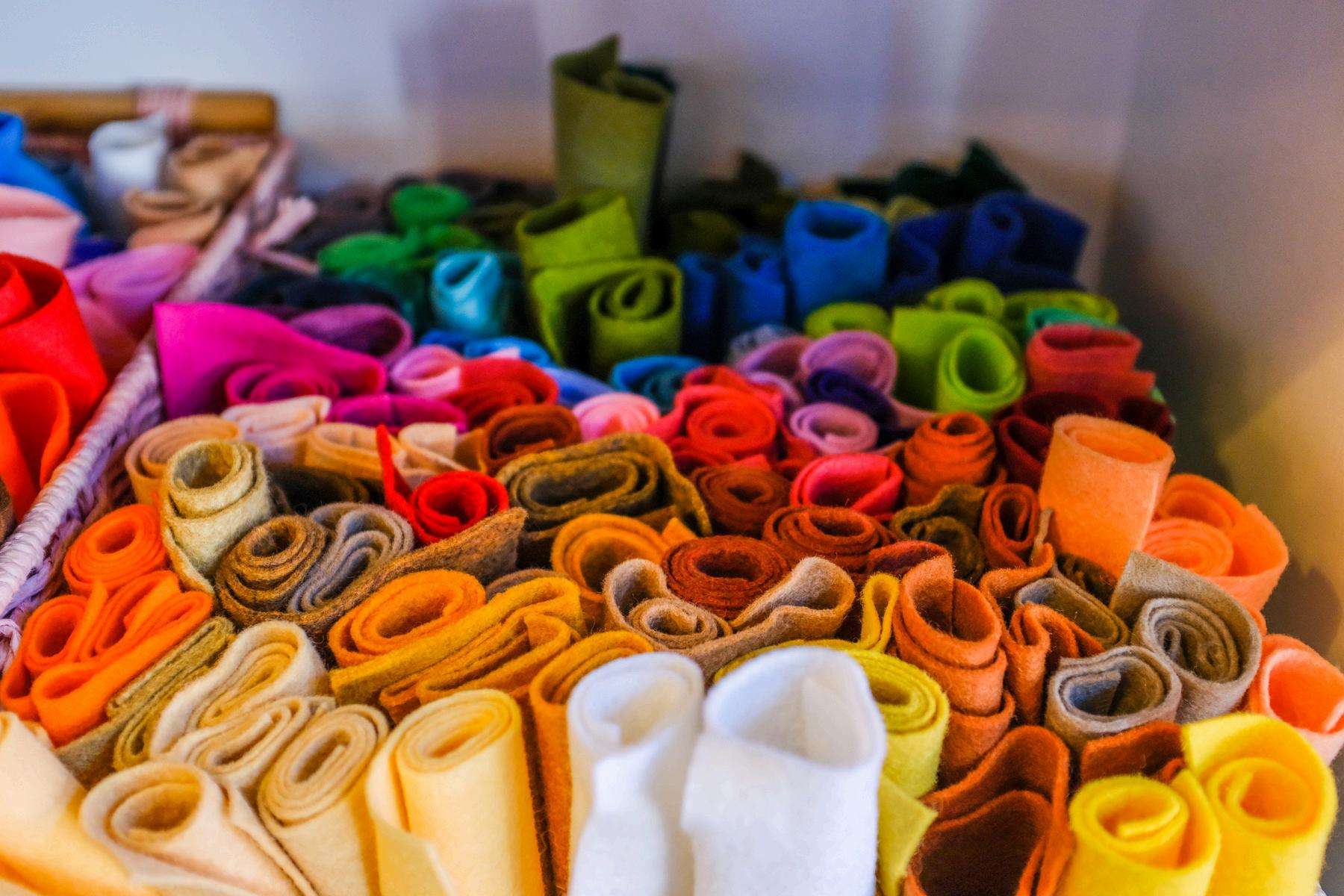
The key component of PICVISA’s fully automated textile sorting machine is the Specim FX17 hyperspectral camera. The Specim FX17 operates in a line-scan mode, collecting hyperspectral data in the nearinfrared (NIR) region spanning from 900 to 1700 nm. NIR hyperspectral imaging allows the identification of the composition of textile products since different textile fibres (natural, artificial, and synthetic) have unique spectral characteristics that can be used for classification.
Using the Specim FX17 hyperspectral camera, PICVISA can capture images and analyse the spectral responses of different materials with exceptional precision.
Daniel Carrero, Technical Director of PICVISA, explains the impact of the Specim FX17 camera:
This technology is a gamechanger. It enables us to identify materials and compositions of garments for pre-selection before recycling, providing a complete analysis with excellent spectral resolution.” “
WWW QD-UKI CO UK 31
find out more
SENSOR-FUSION FOR ENHANCED SORTING ACCURACY
In addition to the Specim FX17 camera, PICVISA integrates various complementary technologies into their textile sorting machine to ensure unparalleled accuracy. These technologies encompass colour separation, defect identification, and contaminant extraction. RGB systems are employed for colour classification, while inductive sensors are used to identify metals in garments.
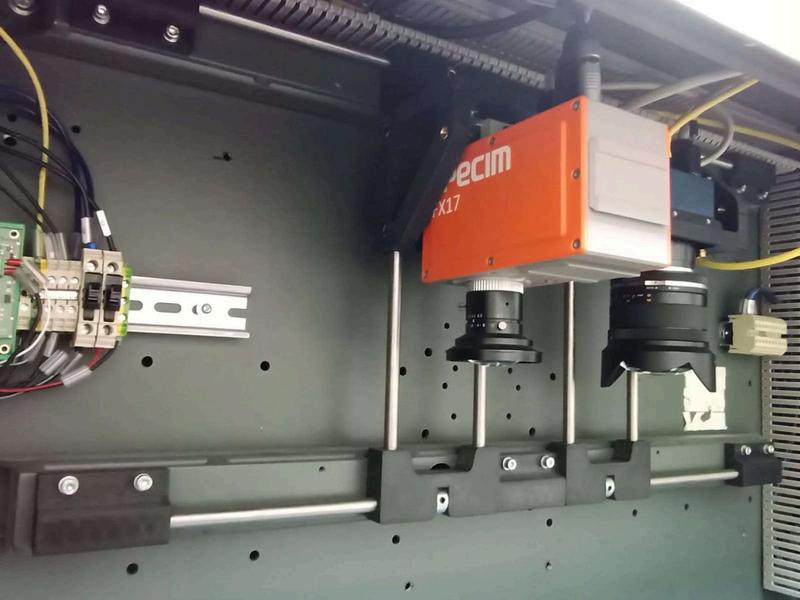
Artificial intelligence (AI) also plays a critical role in PICVISA’s sorting process. By utilising AI algorithms, the company achieves the classification of materials that may be identical in colour and composition but differ in appearance or shape, guaranteeing precise sorting outcomes.
RESPONDING TO CUSTOMERS’ NEEDS IS THE PATH TO SUCCESS
PICVISA’s diligent efforts have resulted in an extensive classification library comprising over 20 compositions. However, customer demand for an even wider range of classifications remains steadfastly increasing. Notably, tackling the identification of elastane has proven challenging for PICVISA, as its
Specim is a partner with exceptional products and service
its recognition is contingent upon particular compositions and proportions. To overcome the obstacle and further develop their solution, PICVISA is actively exploring regression-based classification besides classbased as a potential solution.
REGULATIONS DRIVE INNOVATION AND GROWTH OF TEXTILE RECYCLING
Lluís Seguí, Managing Director of PICVISA, states:
“
For PICVISA, the textile sorting market represents one of the fastest-growing sectors of the future. The development of chemical recycling for mixedfibre garments and finding a solution for already-sorted pure garments will be crucial.”

PICVISA already had experience working with Specim, as the company has previously implemented Specim’s hyperspectral cameras in their automated sorting machines for other segments, such as plastic recycling.
PICVISA’s collaboration with Specim has been highly satisfactory, setting the benchmark for successful partnerships. Regarding their decision to work with Specim, Daniel Carrero emphasises, “We chose Specim for their exceptional product and service. It’s a safe bet, as they offer an industrial-grade solution with fantastic capabilities.”
WWW QD-UKI CO UK 32


THE STUDY OF CIRCADIAN RHYTHMS AND SUPRACHIASMATIC NUCLEUS (SCN) NEURONS
How does studying jet lag in mice improve our health? A recent study led by Huiyan Li, from the National Center of Biomedical Analysis in Beijing, China is looking to understand how Chronobiology affects our wellbeing.
Circadian rhythms are physical, mental, and behavioural changes that follow a 24-hour cycle. This rhythm is governed by the master circadian pacemaker, suprachiasmatic nucleus (SCN) which can orchestrate the peripheral clocks in multiple tissues throughout the body. They have established primary cilia–mediated Sonic Hedgehog (SHH) signaling in the SCN as a novel interneuronal coupling mechanism and may lead to novel therapy of circadian disruptionlinked diseases like high blood pressure, obesity and other metabolic disorders.
In vertebrate animals, the master clock is a group of about 20,000 nerve cells (neurons) that form a structure called SCN, which is in a part of the brain called the hypothalamus and receives direct input from the eyes. It is the central pacemaker of the circadian timing system and regulates most circadian rhythms in the body Your body tries to align your sleep-wake cycle to cues from the environment, such as when it gets light or dark outside, when you eat, and when you are physically active
Environmental circadian disruptions, such as acute jet-lag and long-term shift work, cause temporal unsynchronisation between the internal circadian clock and external time cues, leading to physiological stress Circadian disruption has been implicated in tumorigenesis and various psychiatric, neurological and metabolic diseases, including depression and diabetes. The study of circadian rhythms and suprachiasmatic nucleus (SCN) neurons is an active area of research, and new discoveries continue to expand our understanding of these complex processes.
Primary cilia, specialised hair-like structures are found on the surface of many cells, play crucial role in mammalian embryonic development Tu et al revealed that primary cilia in a subset of SCN neurons cilia exhibit pronounced circadian rhythmicity in abundance and length, and further identify primary cilia as a critical device for intercellular coupling to maintain the circadian clock in the SCN
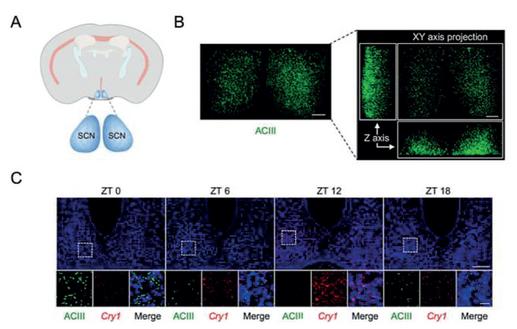
iFig. 1. (A) Schematic diagram of the suprachiasmatic nucleus (SCN). (B) Representative three-dimensional reconstructed projection images of the SCN at 20× magnification of the two-photon imaging are shown. SCN slices were stained with anti-ACIII antibody (primary cilia marker, green). Scale bars, 50 μm. (C) Representative images of primary cilia and expression of clock gene Cry1 in the SCN during lightdark (LD) cycle. Scale bars, 100 μm (main image) and 20 μm (magnified region).

Isolated live SCN neurons from postnatal mice were transduced with modified baculovirus encoding mCherry tagged, constitutively ciliarylocalised protein, 5-hydroxytryptamine receptor 6 (5-HT6). The numbers on the images indicate the time in hours Arrows indicate primary cilia Scale bar, 5 μm (J) Quantitative analysis of the cilium length in (I). Each dot represents one cell.
 Fig 2 - Representative time-lapse images of the primary cilium in SCN neurons for 48 hours
Fig 2 - Representative time-lapse images of the primary cilium in SCN neurons for 48 hours
WWW QD-UKI CO UK 34
In vertebrates, primary cilia are required for transactivation of the Sonic Hedgehog (SHH) signalling. SHH pathways play a significant role in embryonic development and tissue patterning, primarily during early development
The research highlighted that cilia-mediated SHH signalling in the SCN is essential to control the central clock function in mice. They also found that a clinical drug, Vismodegib, blocking SHH signaling, could be used to regulate circadian rhythm, and render mice susceptible to rapid resetting by light. Thus, targeting cilia-mediated SHH signaling might be a potential therapeutic strategy for the treatment of human diseases related to circadian disruptions
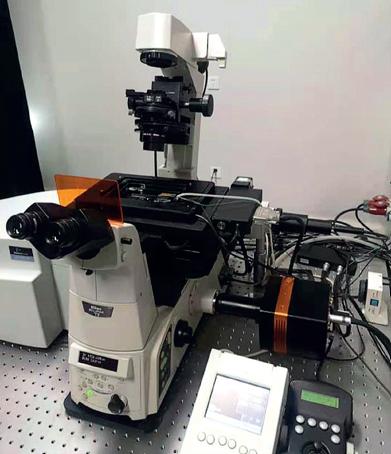
To test whether primary cilia-mediated SHH signaling is required for intercellular coupling among SCN neurons, the researchers used realtime luciferase luminescence imaging of SCN slices isolated from Per2::Luciferase (Per2::Luc) transgenic reporter mice to track Per2 rhythmic expression in single cells ex vivo. In the experimental set-up bioluminescence imaging was used with identical culture conditions for SCN slices with a higher concentration of luciferin (1mM), which was added for imaging
Targeting cilia-mediated SHH signaling might be a potential therapeutic strategy for the treatment of human diseases related to circadian disruptions
The culture dish was sealed and placed on the stage of an inverted microscope with 10x objective lens in a dark room See Fig 3 Images were acquired with three deep-cooled CCD cameras: Andor iKon-M 934, Raptor Eagle 47-10 and Raptor Eagle CCD 42-40 Images of 60 min exposure duration were collected continuously. The Eagle CCD42-40 camera came out as the winner with the optimum performance
Raptor has been developing deep cooled CCD cameras for years. The Eagle family of cooled cameras enables longer integration times Both 4MP and 1MP models are available offering -70°C and -90°C absolute cooling
Ref 1 - Rhythmic cilia changes support SCN neuron coherence in circadian clock- Hai-Qing Tu et al - National Center of Biomedical Analysis in Beijing, China. doi: https:// DOI: 10.1126/science.abm1962
find out more

4
7-year vacuum guarantee – Protection and integrity of the sensor
Extremely low dark current – Deep cooled to greater than -110°C delta enables long exposure times
Back illuminated 4MP sensors from e2v Enables large field of view imaging
13.5μm x 13.5μm pixels (4MP) – Enables ultra sharp image resolution
High QE: >90% @ 525nm and 50% @ 380nm & 720nm –Optimum photon collection
35
Fig 3 - Experimental camera set-up
Fig
- Eagle camera
Compared to its predecessor, the Specim OWL, the new Specim FX120 boasts more spatial and spectral pixels, increased imaging speed, GigE Vision compliant interface, and modern detector technology. This translates into improved uniformity and a greater full well capacity, allowing you to capture more detailed and accurate information.”
AN ADVANCED THERMAL PUSH-BROOM HYPERSPECTRAL CAMERA
Jere Hartikainen, Chief Technical Officer at Specim
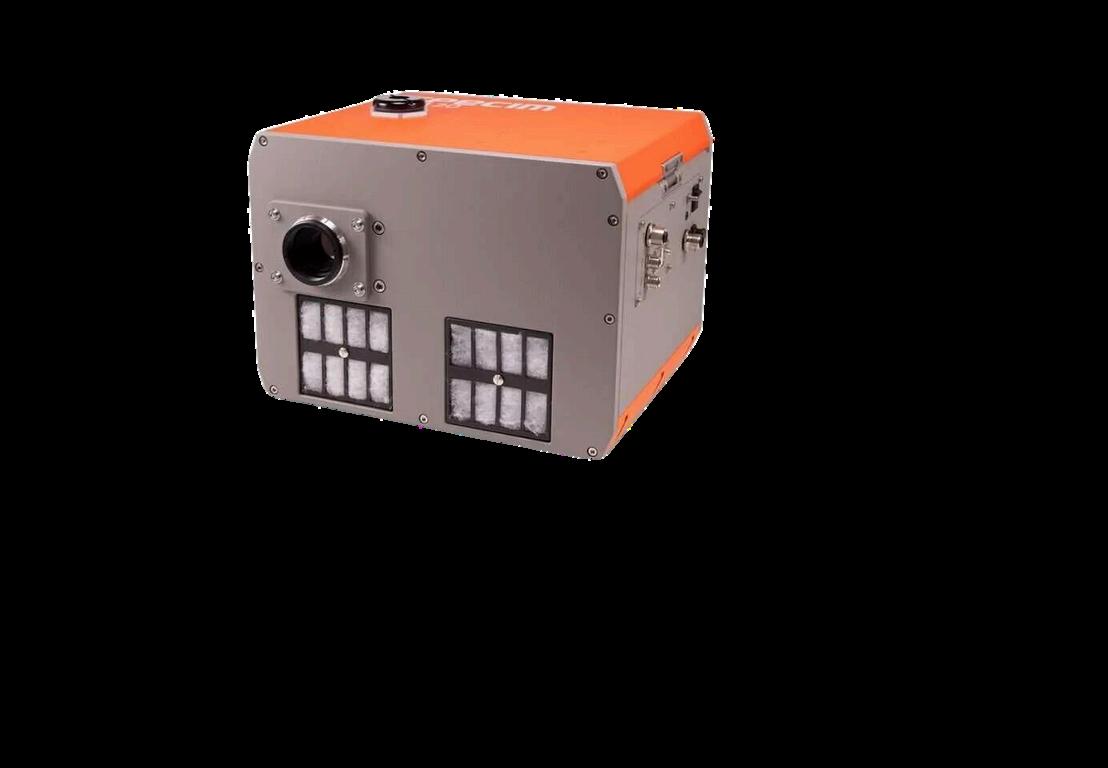
Specim announces its latest innovation, the Specim FX120, an advanced long-wave infrared hyperspectral camera with a full LWIR spectral range of 7.7 to 12.3 µm. This fast push-broom thermal hyperspectral camera is set to redefine chemical imaging capabilities in challenging environments, day and night

With its excellent spectral and spatial imaging performance, the Specim FX120 allows for the
simultaneous capture of all 160 swath-width spectral bands at a high image speed of 240 frames per second.
In conjunction with the SisuRock workstation, the Specim FX120 revolutionises drill-core scanning. Specim FX120 can detect minerals undetectable by other wavelengths, and its speed and accuracy in capturing all sizes of core enhance productivity in drillcore analysis.
find out more

“
SPECIM ANNOUNCES NEW FX120:












SHARE YOUR APPLICATIONS What have you been using imaging cameras for recently? SEND IN YOUR RESEARCH OR WHITE PAPERS We'd love to share your findings HAVE YOUR SAY B E I N C L U D E D I N T H E N E X T E D I T I O N 37 SEND IN YOUR IMAGES Show off your best visuals
Issue No. 1 | Quantum Design UK and Ireland
imaging cameras
Further reading:
Hyperspectral Imaging Cameras
Imaging Cameras
Imaging Cameras Articles
Produced by: Quantum Design UK and Ireland
Unit 1, Mole Business Park, Leatherhead, Surrey, KT22 7BA
+44 (0)1372 378822
info@qd-uki co uk
www qd-uki co uk
Follow us:
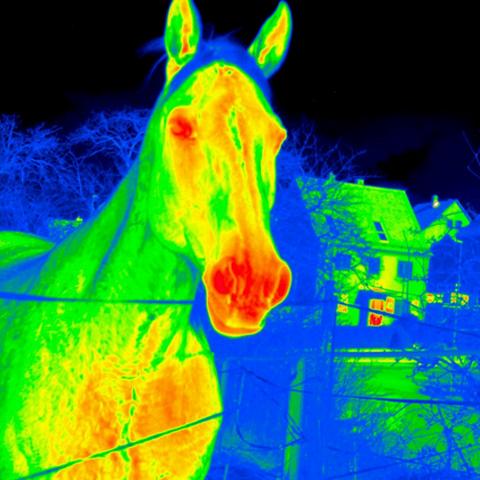



















 Luke Nicholls
CAMERA SALES ENGINEER
Luke Nicholls
CAMERA SALES ENGINEER





 luke@qd-uki co uk
luke@qd-uki co uk

















































 Fig 2. Analysis of the dynamic temperature behaviour of MOFSET modules in 3-phase alternating
Fig.3 Characterisation of integrated passive NiCr resistors on a flip-chip substrate; Left: Measurement setup Right: IR image
Fig 2. Analysis of the dynamic temperature behaviour of MOFSET modules in 3-phase alternating
Fig.3 Characterisation of integrated passive NiCr resistors on a flip-chip substrate; Left: Measurement setup Right: IR image














 Fig 3. Veggie patties with contaminants. Photo (left) and hyperspectral false RGB image (right)
Fig 4. Goat cheese with contaminant. Photo (left) and hyperspectral false RGB image (right).
Fig 5. Spectral comparison of the chicken fillet and the contaminants. Chicken = light brown, PS = red, PE = purple, wood = yellow), metal = green.
Fig 6. Spectral comparison of veggie patties and contaminants. Vegetable steak = brown, PS = red, PE = purple, wood = yellow, metal = green.
Fig 7. Spectral comparison of goat cheese and contaminant. Goat cheese = white, packaging material = red.
Fig 3. Veggie patties with contaminants. Photo (left) and hyperspectral false RGB image (right)
Fig 4. Goat cheese with contaminant. Photo (left) and hyperspectral false RGB image (right).
Fig 5. Spectral comparison of the chicken fillet and the contaminants. Chicken = light brown, PS = red, PE = purple, wood = yellow), metal = green.
Fig 6. Spectral comparison of veggie patties and contaminants. Vegetable steak = brown, PS = red, PE = purple, wood = yellow, metal = green.
Fig 7. Spectral comparison of goat cheese and contaminant. Goat cheese = white, packaging material = red.







































































 Fig 2 - Representative time-lapse images of the primary cilium in SCN neurons for 48 hours
Fig 2 - Representative time-lapse images of the primary cilium in SCN neurons for 48 hours


















